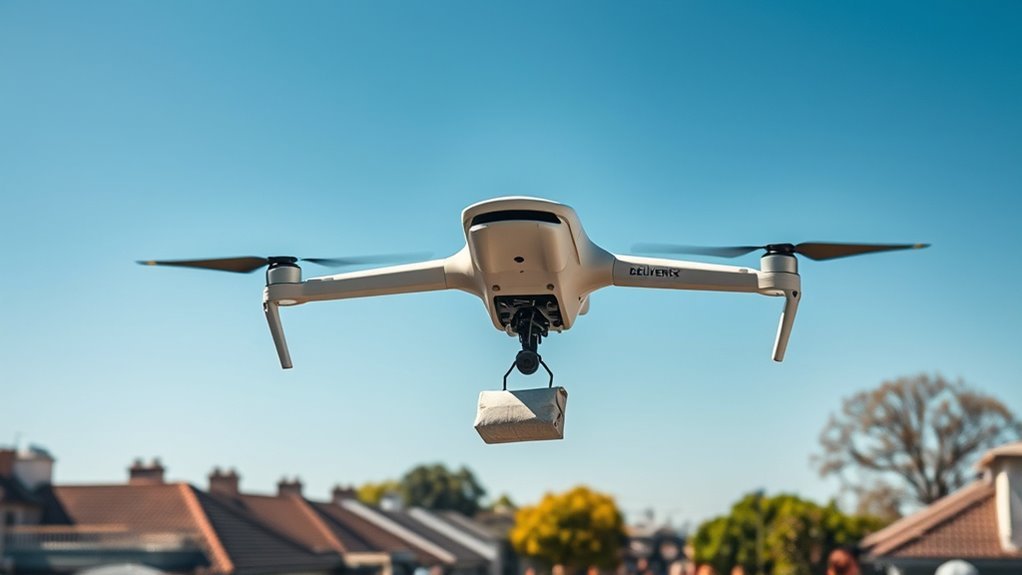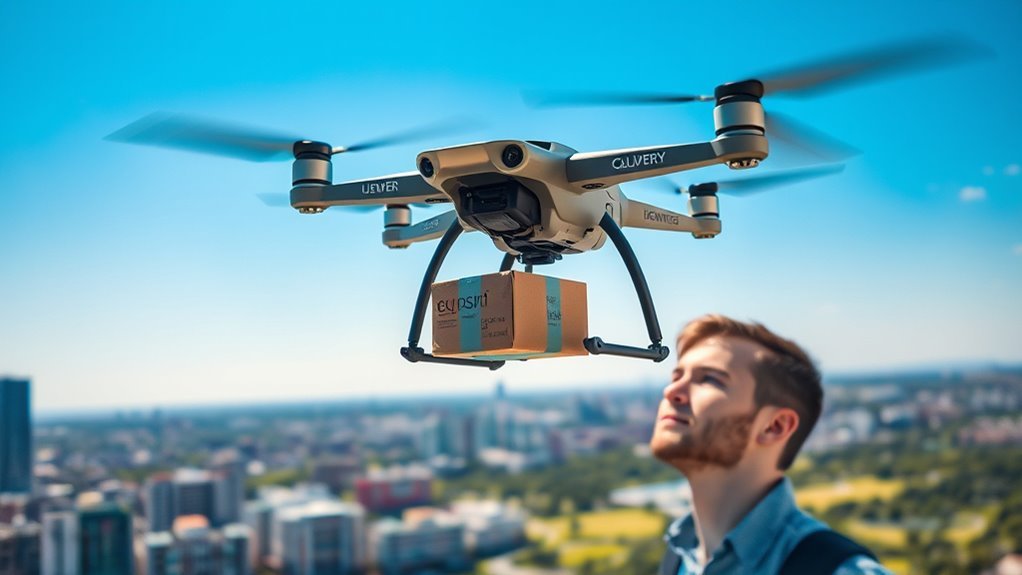Delivery drones are innovative aerial vehicles designed to transport packages swiftly and efficiently. They use advanced technology, including GPS navigation and sensors, to guarantee precise delivery routes. With the ability to reduce delivery times greatly, these drones handle various tasks, from delivering groceries to medical supplies. Their integration of real-time data processing and collision avoidance systems enhances safety and operation. If you’re curious about their impact and future developments, there’s much more to explore.
Understanding Delivery Drones

Delivery drones are revolutionizing the way we think about logistics and transportation. Imagine a world where your packages arrive within minutes, without the hassle of traffic or delays. These innovative devices are at the forefront of drone applications, drastically transforming delivery services. From medical supplies reaching remote areas to groceries arriving at your doorstep, the versatility of drones is astounding. You’re not just witnessing a technological shift; you’re experiencing a newfound freedom in how goods move. As delivery drones become more accessible, the potential for efficiency and convenience expands exponentially. This shift not only benefits consumers but also encourages businesses to rethink their operational strategies, ultimately enhancing the way we connect with products and services. Furthermore, drones can reduce delivery times by up to 70% in challenging terrains, showcasing their potential to enhance logistics in various sectors. Additionally, drones like the Amazon MK30 are designed for efficient urban delivery, emphasizing rapid recharge cycles to support quick operations. Embrace this change; it’s just the beginning.
The Technology Behind Delivery Drones

As you explore the world of delivery drones, it becomes clear that their effectiveness hinges on a combination of advanced technologies. At the heart of this innovation lies drone technology, which integrates GPS navigation, sensors, and cameras to guarantee precise flight paths and obstacle avoidance. Aerial robotics plays an essential role, enabling drones to maneuver in complex environments while carrying payloads efficiently. These machines utilize sophisticated algorithms for real-time data processing, allowing them to adapt to changing conditions swiftly. Furthermore, advancements in battery life and propulsion systems have enhanced their range and reliability. By leveraging these cutting-edge technologies, delivery drones are revolutionizing logistics, empowering you with the freedom to receive goods in unprecedented ways. Notably, the Amazon MK30 exemplifies how advancements in drone design can optimize delivery efficiency, showcasing its 30 minutes of flight time that allows for sustained operations without interruptions.
Types of Delivery Drones

When considering the various types of delivery drones, it’s essential to recognize that their designs cater to specific needs and environments. Cargo drones are built for transporting goods over long distances, efficiently handling large packages. In contrast, commercial drones focus on delivering smaller items, like food or retail products, right to your doorstep. Medical drones serve a critical role, transporting crucial supplies and medications to remote or disaster-stricken areas, often making the difference between life and death. Finally, recreational drones allow you to explore your surroundings or capture stunning aerial footage, offering a sense of freedom and adventure. Each type plays a unique role, shaping how we think about delivery and logistics in our daily lives.
How Delivery Drones Navigate
When it comes to maneuvering, delivery drones rely heavily on GPS technology to pinpoint their exact locations. They also incorporate advanced obstacle detection systems to guarantee safe passage, avoiding potential hazards during flight. Additionally, flight path optimization algorithms help them choose the most efficient routes, saving time and energy. The integration of AI-driven navigation enhances their ability to execute precise urban deliveries, further improving operational efficiency. Furthermore, these drones are equipped with collision avoidance systems that utilize multiple sensors for real-time obstacle detection, ensuring a safe flight experience.
GPS Technology Utilization
GPS technology plays an essential role in guiding delivery drones, allowing them to efficiently reach their destinations with pinpoint accuracy. By leveraging satellite connectivity, these drones can determine their precise location, enabling rapid navigation through diverse environments. With high gps accuracy, delivery drones can plan ideal flight paths, avoiding obstacles and reducing delivery times. This technology not only enhances efficiency but also empowers you with the freedom to receive packages in remote areas that traditional delivery methods might struggle to reach. As advancements in GPS continue to evolve, you’ll likely see even more reliable and precise drone operations. Embracing this technology means embracing a future where convenience and accessibility are prioritized, giving you more control over your delivery experiences.
Obstacle Detection Systems
While GPS technology lays the groundwork for navigation, obstacle detection systems are essential for ensuring delivery drones can safely maneuver through their environments. These systems rely on advanced sensor technology, including cameras, LiDAR, and ultrasonic sensors, to detect various obstacles like trees, buildings, and power lines. By constantly scanning the surroundings, drones can identify potential hazards and employ collision avoidance strategies in real time. This capability not only enhances safety but also allows you to enjoy the freedom of having your deliveries arrive without interruption. As these systems evolve, their accuracy and responsiveness will improve, paving the way for more complex delivery routes and a future where drones can navigate urban landscapes seamlessly, freeing you from the constraints of traditional delivery methods.
Flight Path Optimization
As delivery drones take to the skies, optimizing their flight paths becomes essential for efficiency and timely deliveries. You’ll find that advanced algorithms analyze real-time data, helping these drones navigate obstacles and choose the quickest routes. By considering factors like weather conditions, air traffic, and no-fly zones, flight efficiency is maximized. This dynamic navigation not only shortens the delivery time but also enhances delivery accuracy, ensuring packages arrive at the correct destinations without delays. With each flight, the drones collect data, refining their algorithms for future trips. This continuous improvement means you can expect faster and more reliable service, giving you the freedom to enjoy seamless deliveries right to your door.
Payload Management and Delivery Efficiency
When it comes to delivery drones, managing payload capacity is vital for maximizing efficiency. You’ll want to take into account how much weight your drone can carry without compromising its speed or range. Additionally, employing effective route optimization techniques can greatly enhance delivery times and reduce operational costs. Furthermore, understanding delivery accuracy is essential, as it can significantly impact logistics operations and customer satisfaction. Moreover, the integration of AI-powered obstacle detection in drones enhances their ability to navigate urban environments, ensuring safer and more reliable deliveries.
Payload Capacity Considerations
Payload capacity is a critical factor in the efficiency of delivery drones, influencing both operational success and customer satisfaction. You’ll find that the payload weight directly impacts how far a drone can travel. The heavier the load, the shorter the delivery range becomes, which can limit the areas you can service effectively. This trade-off is essential for optimizing delivery efficiency. Striking a balance between payload weight and distance guarantees your drone can deliver packages swiftly without compromising performance. As you consider your delivery needs, understanding these dynamics allows for better planning and resource allocation. Ultimately, maximizing payload capacity while maintaining an impressive delivery range can elevate your service and enhance the freedom of choice for your customers.
Route Optimization Techniques
Effective route optimization techniques are crucial for enhancing delivery efficiency in drone operations. By employing advanced route planning methods, you can notably reduce delivery times and operational costs. The heart of this process lies in algorithm efficiency, which determines how quickly and accurately the drone can calculate the best path. Utilizing algorithms that factor in real-time data, like weather conditions and air traffic, allows for dynamic adjustments, confirming that your drone navigates the most efficient route possible. Additionally, incorporating payload management strategies guarantees that your drone balances weight distribution, maximizing its range and stability. With these techniques, you can not only enhance delivery speed but also expand your operational freedom, allowing for a more responsive and adaptable delivery service.
Regulatory Challenges and Safety Measures
As the use of delivery drones expands rapidly, maneuvering regulatory challenges and implementing robust safety measures becomes essential to guarantee their safe integration into airspace. You’ll find that achieving regulatory compliance isn’t just about following laws; it’s about fostering trust among consumers and authorities alike. Governments need to establish clear guidelines that address airspace congestion, privacy concerns, and operational limits. Collision avoidance technology is crucial for ensuring safe operations and mitigating risks associated with autonomous flights. Moreover, ensuring compliance with local regulations plays a significant role in the operational success of delivery drones. Safety standards play a vital role here, ensuring that drones are equipped with fail-safe technologies and reliable communication systems. These measures not only protect the public but also enhance the overall efficiency of drone operations. By balancing innovation with stringent regulations, we can enjoy the freedom that delivery drones promise while maintaining a secure airspace for everyone involved.
Future Prospects of Delivery Drones in Logistics
While many industries are already seeing the benefits of drone technology, the future prospects of delivery drones in logistics promise to revolutionize the way goods are transported. Market trends indicate a growing shift toward automated solutions, with drones leading the charge in efficiency and speed. As consumer acceptance increases, you might find yourself enjoying faster deliveries and reduced shipping costs. Companies are investing heavily in this technology, aiming to meet rising customer demands while minimizing their carbon footprint. With advances in navigation and safety protocols, the potential for drones to streamline logistics is immense. Additionally, precision planting techniques used in agriculture highlight how drones can optimize resource allocation, further enhancing logistics efficiency. Embracing these innovations could grant you the freedom of receiving your orders at unprecedented speed, transforming your shopping experience in ways we can only begin to imagine. Moreover, the potential US ban on DJI drones could accelerate the development of competing delivery drone technologies, driving further improvements in service reliability and efficiency.
Frequently Asked Questions
Are Delivery Drones Environmentally Friendly Compared to Traditional Delivery Methods?
Picture a world where delivery drones zip through the skies, drastically reducing carbon footprints. While they’re not magic, they often lessen environmental impact compared to traditional methods, addressing sustainability concerns and offering a greener future.
What Types of Products Can Delivery Drones Transport?
Delivery drones can transport a variety of products, from medical supplies to grocery items. They’re revolutionizing convenience, allowing you to receive essential goods quickly, enhancing your freedom to access what you need, when you need it.
How Are Delivery Drones Powered?
Like a bird soaring on the wind, delivery drones rely on advanced battery technology for power. Their energy efficiency maximizes flight time, allowing you to enjoy quicker deliveries while embracing the freedom of modern logistics.
Can Delivery Drones Operate in Bad Weather Conditions?
You might find delivery drones face significant operational limits in bad weather. Rain, snow, or strong winds present weather challenges that can affect their navigation and safety, often leading to delays or cancellations of deliveries.
What Is the Cost of a Delivery Drone Service?
When considering drone pricing, you’ll find service fees vary based on factors like distance and delivery speed. It’s essential to evaluate these costs against your needs for efficiency and convenience in your daily life.

